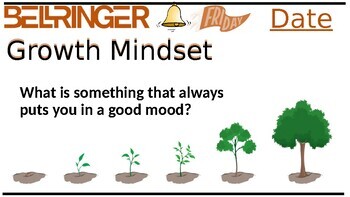110 Daily STEM Bellringers Half of School Year & Bonus Growth Mindset Prompts
Teaching Youth by Design
3 Followers
Grade Levels
5th - 12th
Subjects
Resource Type
Standards
CCSS7.SP.A.1
CCSS7.SP.C.5
CCSSCCRA.L.3
CCSSRST.9-10.4
CCSSMP1
Formats Included
- PPTX
Pages
133 pages
Teaching Youth by Design
3 Followers
What educators are saying
These had such great variety so the kids didn't get bored or annoyed with the same types of things every day! Very approachable for my 7th and 8th graders!
Description
110 Individual slides for daily Science, Technology, Engineering, and Math bellringers with questions and multiple-choices, answers included. Daily themes for STEM Technology Classroom Journal. Can be used as digital journal or for display with a smart-board. Designed to get students to work quickly, at the start of class. Product is a downloadable and editable PowerPoint presentation with answer in animation with click and in outline. Product is divided by 22 weeks.
Total Pages
133 pages
Answer Key
Included
Teaching Duration
Lifelong tool
Report this resource to TPT
Reported resources will be reviewed by our team. Report this resource to let us know if this resource violates TPT’s content guidelines.
Standards
to see state-specific standards (only available in the US).
CCSS7.SP.A.1
Understand that statistics can be used to gain information about a population by examining a sample of the population; generalizations about a population from a sample are valid only if the sample is representative of that population. Understand that random sampling tends to produce representative samples and support valid inferences.
CCSS7.SP.C.5
Understand that the probability of a chance event is a number between 0 and 1 that expresses the likelihood of the event occurring. Larger numbers indicate greater likelihood. A probability near 0 indicates an unlikely event, a probability around 1/2 indicates an event that is neither unlikely nor likely, and a probability near 1 indicates a likely event.
CCSSCCRA.L.3
Apply knowledge of language to understand how language functions in different contexts, to make effective choices for meaning or style, and to comprehend more fully when reading or listening.
CCSSRST.9-10.4
Determine the meaning of symbols, key terms, and other domain-specific words and phrases as they are used in a specific scientific or technical context relevant to grades 9–10 texts and topics.
CCSSMP1
Make sense of problems and persevere in solving them. Mathematically proficient students start by explaining to themselves the meaning of a problem and looking for entry points to its solution. They analyze givens, constraints, relationships, and goals. They make conjectures about the form and meaning of the solution and plan a solution pathway rather than simply jumping into a solution attempt. They consider analogous problems, and try special cases and simpler forms of the original problem in order to gain insight into its solution. They monitor and evaluate their progress and change course if necessary. Older students might, depending on the context of the problem, transform algebraic expressions or change the viewing window on their graphing calculator to get the information they need. Mathematically proficient students can explain correspondences between equations, verbal descriptions, tables, and graphs or draw diagrams of important features and relationships, graph data, and search for regularity or trends. Younger students might rely on using concrete objects or pictures to help conceptualize and solve a problem. Mathematically proficient students check their answers to problems using a different method, and they continually ask themselves, "Does this make sense?" They can understand the approaches of others to solving complex problems and identify correspondences between different approaches.





